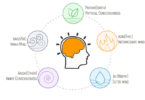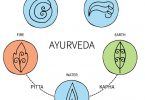Do you practice yoga? I believe your answer will be yes.
Why do you practice yoga? Most probably your answer will be for “well being”.
Is yoga enough to achieve complete wellness? I would say not actually, combined understanding of Yoga and Ayurveda is important for us to achieve complete well being. Yoga and Ayurveda are two interrelated branches of the same great tree of Vedic knowledge.
The word Ayurveda consists of two words Ayu and Vada. The word Ayu is derived from the primary word Ayus meaning life, Ayu is explained in Charak Samhita as a combination of Sharira (physical body), Indriya (senses), Manaha (mind) and Atman (soul). The word Veda originates from the word Vid, which means knowledge. Thus Ayurveda roughly translates as “knowledge of life”. The origin of Ayurveda could be more than 5000 years when writing system was not even evolved. It is believed that the Vedic knowledge was passed through cognition or was gained through meditation. Knowledge of Ayurveda includes use of various methods of healing, prevention, longevity and surgery. The Vedas consider as oldest exiting text. The Vedas are comprised of 4 major books (Rig, Yajur, Sam, and Atharv) which deal with various aspects of life. The oldest Veda book is Rig Veda. Rig Veda details many great concepts such as concepts of cosmology, tridosha theory, herbs and their use as medicines and more. However it is in the Atharvaveda where major references of Ayurveda are found. Atharvaveda gives a systematic description of Ashtang Ayurveda or the 8 branches of Ayurveda.
- Kaya Chikitsa – internal medicine.
- Shalyatantra – surgery.
- Shalkyatantra – study of head and neck (ophthalmology and oto-rino-laryngology)
- Agadtantra – toxicology.
- Bootvidya – spiritual healing and psychiatry.
- Kaumar and Prasutitantra – pediatrics and gynecology.
- Rasayan – geriatrics and rejuvenation.
- Vaajikaran – reproduction and fortification of carnal pleasures.
Ayurveda and its streams were propagated through two schools at that time. First is Atreya Sampradaya or the school of physician, second is Dhanvantri Sampradaya or the school of surgeons. These two systems make Ayurveda more scientifically verifiable and classifiable medical system. Charak Samhita, Sushurut Samhita and Ashtanga Hridayam are the well known text of Ayurveda.
Ayurveda practice was at its peak in the Buddhist era around (500BC). This period was the growth of Ras-shastra and Siddha medicine, which is marked by the prominent use of mercury sulphur and metals in conjunction with herbs to prepare medication. But prior to this Ayurveda medicine were only constituted of herbs and certain minerals.
In the time of Chandra Gupta Maurya (300 bc) Ayurveda was an established health care system of India, this period could be classified as the golden period of Ayurveda. Emperor Ashoka (304-232BC) was highly influenced by Buddhist teaching after the Kalinga war, implemented the path of peace and spirituality, thus refraining from injuries and bloodshed.
Decline of Ayurveda Mughal invasion of India saw destruction of many Ayurveda treatises as the Mughals razed down ancient universities like Takshila and Nalanda which housed huge compilations. The Mughals were known for their high indulgence in carnal pleasures. Therefore during the Mughal regime Rasayan and Vaajikaran stream of Ayurdeva received heavy patronage, taking Ayurveda to a high level and continued to do so until Indian faced colonization by the British, which resulted in the massive decline of the Ayurveda practices and the implementation of our modern health care system.





